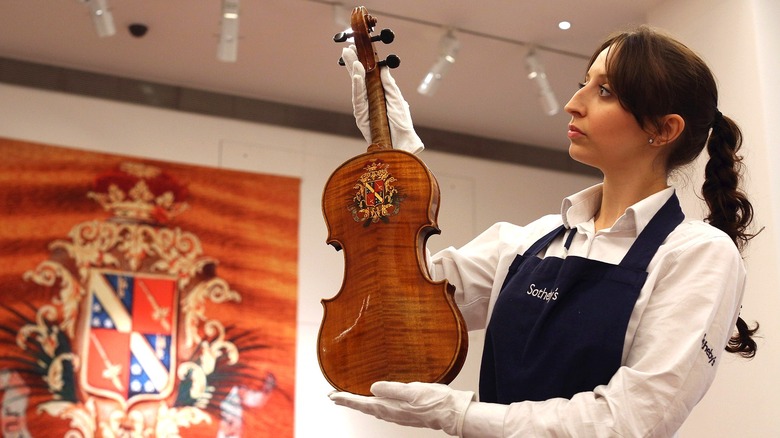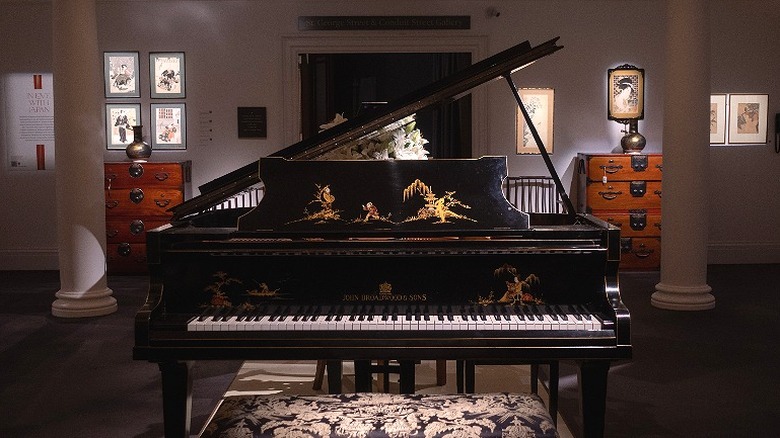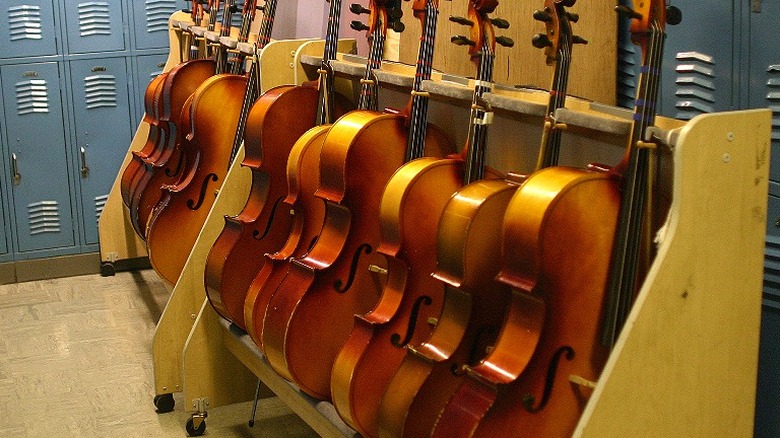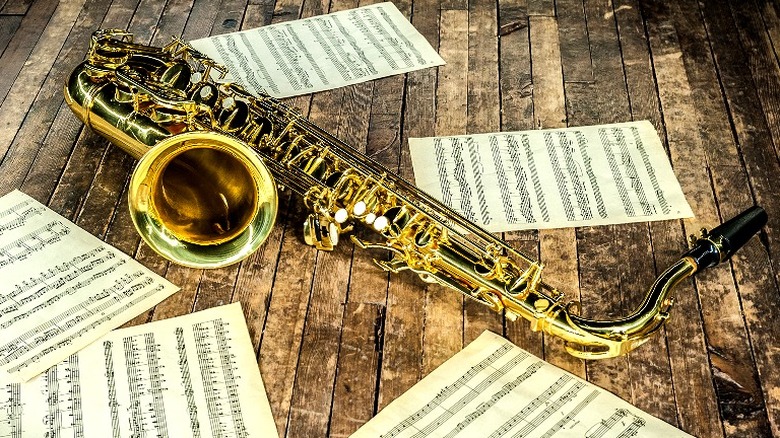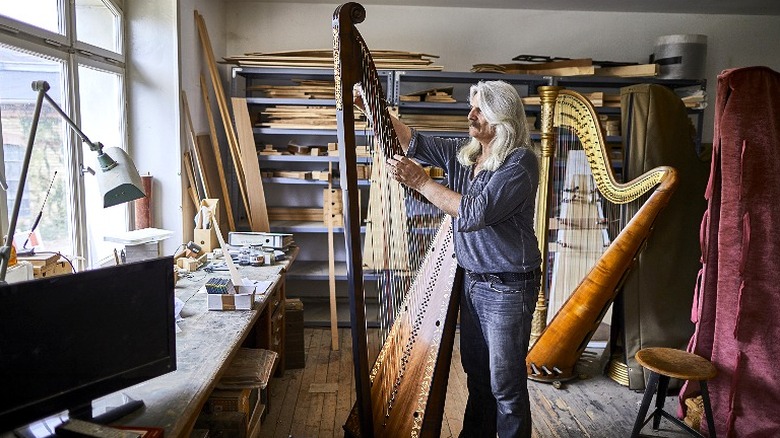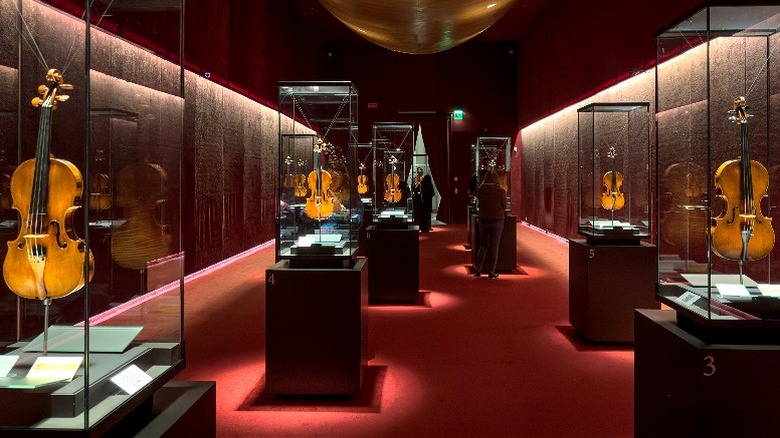Unexpected Musical Instruments That Are Worth A Ton Of Money
At Money Digest, we've talked about why too much diversification in your portfolio can be dangerous; however, we've also spoken of the importance of having assets that appreciate in value. According to Statista, Americans spent an average of $30.8 million per quarter on musical instruments in 2023, in a market that's anticipated to reach $6 billion by the end of 2024. What's more, the pandemic impact of closed stores only caused online sales to rise, with the sale of musical instruments projected to grow by 5.06% from 2024 to 2028. That points to a sustainable market and potential investment if you know what instruments to look for and how to keep them valuable.
The valuation of musical instruments can be influenced greatly by reputation and the demand for the instruments versus how rare or scarce they are. The condition of your instrument will obviously have an impact on the resale value of it, too. Further, the quality of materials used can mean the difference between a $4,000 student-level purchase and a $35,000-plus professional collector item. Over the years, instruments have sold for hundreds of thousands to millions of dollars. Before you post your old trumpet on eBay for a handshake and a smile, take a closer look at it, as you might be giving away a ton of money.
Grand piano
Note that the price point between a brand-new digital grand piano and an acoustic grand piano is a conservative difference of $5,000 or much more. Also, just because an acoustic grand piano costs significantly more, it's no guarantee of high resale value since everything from the manufacturer going out of business, to the demand for the instrument can actually depreciate the value. This is where manufacturer reputation and quality will make all the difference. Look for a piano manufactured by Steinway & Sons, C. Bechstein, or Bösendorfer — the premier league of piano manufacturers.
On Piano Buyer, a semiannual consumer guide to buying, selling, and maintaining pianos, you will find pianos listed by manufacturer, price range, and quality. As of this writing, the manufacturer's suggested retail price (MSRP) for a Bösendorfer on the low end is $157,999, while the suggested maximum price (SMP) is $148,998, representing a difference of 5.7%. On the high end, meanwhile, an MSRP of $591,999 to a SMP of $554,998 isn't much different at 6.25%, meaning this piano retains most of its resale value on both ends.
Cello
The cello is appreciated for its similarity to the full range of the human voice. A quality instrument can be purchased in the low end for around $1,500, to a luxurious price of a million dollars and over. While not the cheapest instrument, spending a little more on a well-made cello offers the benefit of owning an appreciative asset that will retain most of its value, and may provide a financial cushion when you need it most.
Where the cello is concerned, the age of the materials don't take away from the value of the instrument, so long as the materials are of stellar quality. According to StringWorks, cellos under $1,000 are made with low-quality laminates; you'll pay $1,000 just for the wood in a decent cello, so anything under that amount is suspect. The quality of the wood isn't just about aesthetics, though. Wood quality also affects the quality of sound the instrument makes, which is influenced by the vibration of sound against the wood. The wood materials, called tonewoods for their acoustic properties, have their own audio characteristics, making them an integral factor in determining their value as investments.
Antonio Stradivari was a master instrument maker who handmade 80 cellos in his lifetime, several of which were prized for their playability and craftsmanship. One of these cellos was the Duport Stradivarius made in 1711. Once played by Napoleon, the only cello of its kind is valued at $20 million.
Saxophone
Like sports collectibles that are most likely to grow in value over time, you're better off sourcing something older if it's an investment. Newer saxophones are usually mass produced, meaning they tend to be made of lesser quality materials to save on the cost of manufacturing. An older saxophone that's been maintained in good condition and plays well usually leads to higher quality standards, and extra attention in the form of engraving, plating versus lacquering, and an overall better playing experience.
As mentioned previously, aside from quality of materials, condition, and the reputation of the manufacturer, the reputation of past users can factor greatly in the value of your instrument. For example, one of the world's most influential saxophone players, Charlie Parker, performed at Massey Hall in 1953. The saxophone he played is currently on view at the American Jazz Museum in Parker's hometown of Kansas City, Missouri, and, as reported by NPR, was purchased at auction in 1994 for $144,000. With inflation, that's the equivalent today of $305,485 and is the most ever paid for a saxophone.
Harp
The harp is an elegant instrument that conjures up images of fancy concertos and angel wings, and it's also one of the best instruments to invest in as an asset. If you want a harp that holds or appreciates in value, go with a pedal harp (versus a lever harp) since its production is more complex and requires more quality materials. Again, materials matter, and in the harp's case, it's the type and quality of the wood used. Design elements can also affect the value of a harp. Although harps can depreciate by 20% to 30% over time, according to the Hong Kong Harp Centre, starting with the highest quality harp and keeping it in good condition can help you hold on to the value.
In 1889, after years of research and development, George W. Lyon and Patrick J. Healy revealed their first harp produced under the banner of their company Lyon & Healy. From there, they went on to create several more sought-after harps, including the Style 23, a highly regarded and popular instrument with highlights like floral carvings and fleur-de-lis patterns throughout. Their premium harp, the Louis XV Special, with hand-painted and engraved floral imagery and 23-karat gold leaf wrap, is indeed something special. With a price tag of $257,500, this is one of the more expensive and valuable instruments on our list.
Violin
The violin is another beloved orchestral instrument that's also a worthwhile investment. The first thing to secure a violin that's likely to appreciate in value is to find something rare and in high demand by players and collectors alike. The manufacturer's reputation always matters, and the skill required to maintain or repair an older violin should be on the same level as the instrument's original craftsmanship. If the manufacturer is more contemporary, the reputation and caliber of musicians who choose that particular make or model may be more important to the valuation of the instrument. Be sure to do some research on the violin in question and have your violin appraised by a professional dealer before purchasing one.
The Stradivarius violin, crafted in the late 1600s by its namesake Antonio Stradivari, is a rare piece of classic instrumentation. There are believed to be only 650 left in existence, and that scarcity combined with a level of craftsmanship considered superior to others sets these violins apart. A violin dealer quoted in the lifestyle magazine Square Mile suggested the return on investment for a Stradivarius could be anywhere from 26% to 60%. The average professional violin can cost anywhere from $3,000 to $10,000. The five most valuable violins in the world are worth between $10 million to $20 million, and all five are Stradivarius violins.
